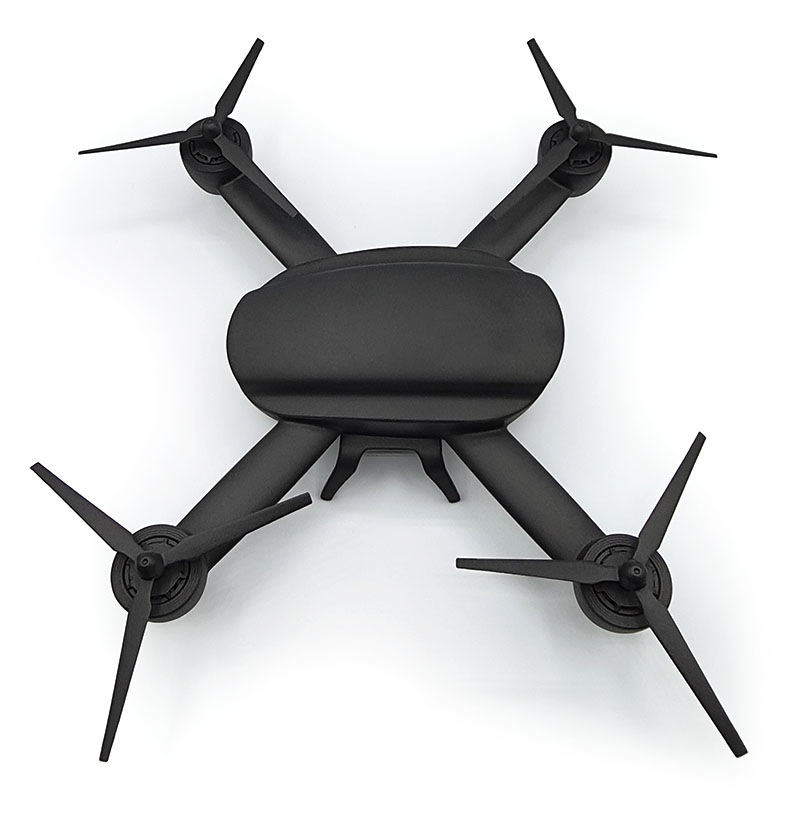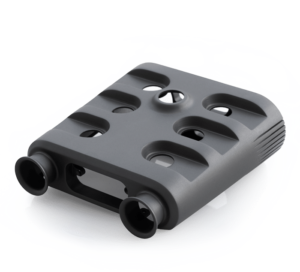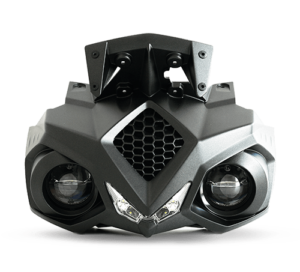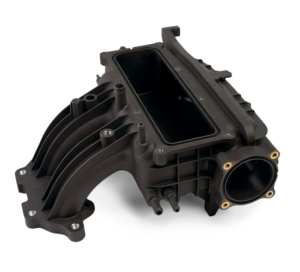Class of Material
Carbon fiber filled composite material polyamide based
Technology
Selective Laser Sintering
FEATURES
High stiffnessLow densityResistant to high temperature
KEY VALUES
Density 20°C: 0,87 g/ccHDT 1,82 Mpa: 182,5 °CTensile Strength: 52,82 MpaTensile Modulus: 4033,40 Mpa
APPLICATIONS
Parts requiring lightness, stiffness and resistance to high-temperatureUAV/drones components (e.g. central body, arms)
FEATURES
High stiffnessLow densityResistant to high temperature
Which characteristics
are you searching for?
KEY VALUES
Density 20°C: 0,87 g/ccHDT 1,82 Mpa: 182,5 °CTensile Strength: 52,82 MpaTensile Modulus: 4033,40 Mpa
Technical data sheet
DownloadAPPLICATIONS
Parts requiring lightness, stiffness and resistance to high-temperatureUAV/drones components (e.g. central body, arms)
Windform successful stories
Get inspiredTechnical Properties
Density: 0,87 g/cc
Colour:
BLACK
| Thermal Properties | Test Method | SI Unit | US Unit |
|---|---|---|---|
| Melting point | ISO 11357 | 195,00 °C | 383.00 °F |
| HDT, 1.82 Mpa | ISO 75 Method A | 182,50 °C | 360.50 °F |
| Vicat 10N | ISO 306 Method A50 | 190,00 °C | 374.00 °F |
| Flammability Properties | Test Method | SI Unit | US Unit |
|---|---|---|---|
| Burning Test - HB 1mm | UL 94 | HB | HB |
| Burning Test - HB 3mm | UL 94 | HB | HB |
| Mechanical Properties | Test Method | SI Unit | US Unit |
|---|---|---|---|
| Tensile Strength - XY axis | UNI EN ISO 527-1 | 52,82 Mpa | 7660.89 psi |
| Tensile Strength - YX axis | UNI EN ISO 527-1 | 44,04 Mpa | 6387.46 psi |
| Tensile Strength - ZX axis | UNI EN ISO 527-1 | 30,16 Mpa | 4374.34 psi |
| Tensile Strength - ZY axis | UNI EN ISO 527-1 | 27,98 Mpa | 4058.16 psi |
| Tensile Modulus - XY axis | UNI EN ISO 527-1 | 4033,40 Mpa | 585.00 ksi |
| Tensile Modulus - YX axis | UNI EN ISO 527-1 | 2851,80 Mpa | 413.62 ksi |
| Tensile Modulus - ZX axis | UNI EN ISO 527-1 | 2473,20 Mpa | 358.71 ksi |
| Tensile Modulus - ZY axis | UNI EN ISO 527-1 | 2455,40 Mpa | 356.13 ksi |
| Elongation at Break - XY axis | UNI EN ISO 527-1 | 5,84 % | 5.84 % |
| Elongation at Break - YX axis | UNI EN ISO 527-1 | 8,26 % | 8.26 % |
| Elongation at Break - ZX axis | UNI EN ISO 527-1 | 1,78 % | 1.78 % |
| Elongation at Break - ZY axis | UNI EN ISO 527-1 | 1,58 % | 1.58 % |
| Flexural Strength | UNI EN ISO 14125 | 90,88 Mpa | 13181.03 psi |
| Flexural Modulus | UNI EN ISO 14125 | 3789,00 Mpa | 549.55 ksi |
| Impact Strength Unnotched (Charpy 23 °C/73.4 °F) | UNI EN ISO 179-1 | 22,40 KJ/m2 | 10.65 ft-lb/in2 |
| Impact Strength Unnotched (Charpy -30 °C/-22 °F) | UNI EN ISO 179-1 | 24,50 KJ/m2 | 11.65 ft-lb/in2 |
| Impact Strength Notched (Charpy 23 °C/73.4 °F) | UNI EN ISO 179-1 | 6,40 KJ/m2 | 3.04 ft-lb/in2 |
| Impact Strength Notched (Charpy -30 °C/-22 °F) | UNI EN ISO 179-1 | 5,90 KJ/m2 | 2.81 ft-lb/in2 |
| Impact Strength Unnotched (Izod 23 °C/73.4 °F) | UNI EN ISO 180 | 20,30 KJ/m2 | 9.65 ft-lb/in2 |
| Impact Strength Unnotched (Izod -30 °C/-22 °F) | UNI EN ISO 180 | 24,30 KJ/m2 | 11.56 ft-lb/in2 |
| Impact Strength Notched (Izod 23 °C/73.4 °F) | UNI EN ISO 180 | 6,00 KJ/m2 | 2.85 ft-lb/in2 |
| Impact Strength Notched (Izod -30 °C/-22 °F) | UNI EN ISO 180 | 5,80 KJ/m2 | 2.76 ft-lb/in2 |
| Hardness Shore D | UNI EN ISO 868 | 79 | 79 |
| Poisson Ratio - XY axis | UNI EN ISO 527-2 | 0,37 | 0.37 |
| Poisson Ratio - YX axis | UNI EN ISO 527-2 | 0,27 | 0.27 |
| Poisson Ratio - ZX axis | UNI EN ISO 527-2 | 0,24 | 0.24 |
| Poisson Ratio - ZY axis | UNI EN ISO 527-2 | 0,35 | 0.35 |
| Electrical Properties | Test Method | SI Unit | US Unit |
|---|---|---|---|
| Resistivity, Volume | ASTM D257-14 | < 10^7 ohm*cm | < 10^7 ohm*cm |
| Resistivity, Surface | ASTM D257-14 | < 10^7 ohm | < 10^7 ohm |
| CTI Comparative Tracking Index | IEC 60112 Solution A | 200 Volt | 200 Volt |
| Surface Finish | SI Unit | US Unit |
|---|---|---|
| After SLS Process | 5,44 Ra µm | 5.44 Ra µm |
| After manual finishing | 1,56 Ra µm | 1.56 Ra µm |
| After CNC machining | 0,83 Ra µm | 0.83 Ra µm |
| Properties per Density Unit | SI Unit | US Unit |
|---|---|---|
| UTS per density unit | 60,64 Mpa/(g/cc) | 8795.09 psi/(g/cc) |
| Tensile Modulus per density unit | 4630,77 Mpa/(g/cc) | 671.64 ksi/(g/cc) |
| Flexural Strength per density unit | 104,34 Mpa/(g/cc) | 15133.24 psi/(g/cc) |
| Flexural Modulus per density unit | 4350,17 Mpa/(g/cc) | 630.94 ksi/(g/cc) |
Note: The material properties provided herein are for reference purposes only. Data was generated from the testing of parts produced with Windform SL material under optimal processing conditions. Actual values may vary significantly as they are affected by part geometry and process parameters. Material specifications are subject to change without notice.
Standard Technical Details for Accuracy versus Tolerance:
For parts up to 1 mm (0.039″), the standard tolerance is ± 0,070 mm (0.003″)
For parts up to 3 mm (0.118″), the standard tolerance is ± 0,125 mm (0.005″)
For parts up to 6 mm (0.236″), the standard tolerance is ± 0,150 mm (0.006″)
For parts over 6 mm (0.236″), refer to UNI EN ISO 286-2 JS14 class (linear tolerances).

Technical specifications
Windform SL is the twelfth material in the Windform TOP-LINE range for selective laser sintering. Its exceptional lightness, with a density of 0.87 g/cc, coupled with carbon fiber reinforcement, positions it as an optimal choice for applications demanding lightweight components without compromising structural integrity.
The stiffness of Windform SL is evident in key metrics such as the XY-axis Tensile Strength at 52.82 MPa and the XY-axis Tensile Modulus at 4033.40 MPa. These properties empower the material to maintain form and structural stability even under substantial loads, ensuring reliable performance in demanding scenarios.
Windform SL distinguishes itself with notable heat resistance, boasting a Heat Distortion Temperature (HDT) of 182.5°C at 1.82 MPa. This feature makes the material suitable for operational contexts requiring superior thermal stability, preserving its performance in adverse environmental conditions.
Impressive impact resistance is another strength of Windform SL, as evidenced by Charpy and Izod tests, showcasing its ability to withstand dynamic forces without compromising structural integrity.
The post-processing surface finish is equally noteworthy, with Ra values of 5.44 µm after the SLS process, 1.56 µm after manual finishing, and 0.83 µm after CNC machining. These values ensure the achievement of smooth and precise surfaces, establishing Windform SL as a technologically advanced material for demanding applications.
Applications
Windform SL finds extensive applications in the drone/UAV sector, such as in the manufacturing of the central body and arms. The material’s lightweight nature translates to increased flight autonomy, while its stiffness provides the necessary robustness to withstand various operational conditions. Furthermore, its high-temperature resistance allows greater versatility in scenarios where temperatures may vary significantly.
Beyond UAV applications, Windform SL is optimal for uses requiring a combination of lightweight, stiffness, and high-temperature resistance. Industry sectors such as aerospace and automotive can benefit from its advanced performance, enabling the creation of sophisticated and efficient components tailored to their specific utilization contexts.

You might be also interested in

Carbon filled-composite material with excellent mechanical characteristics

